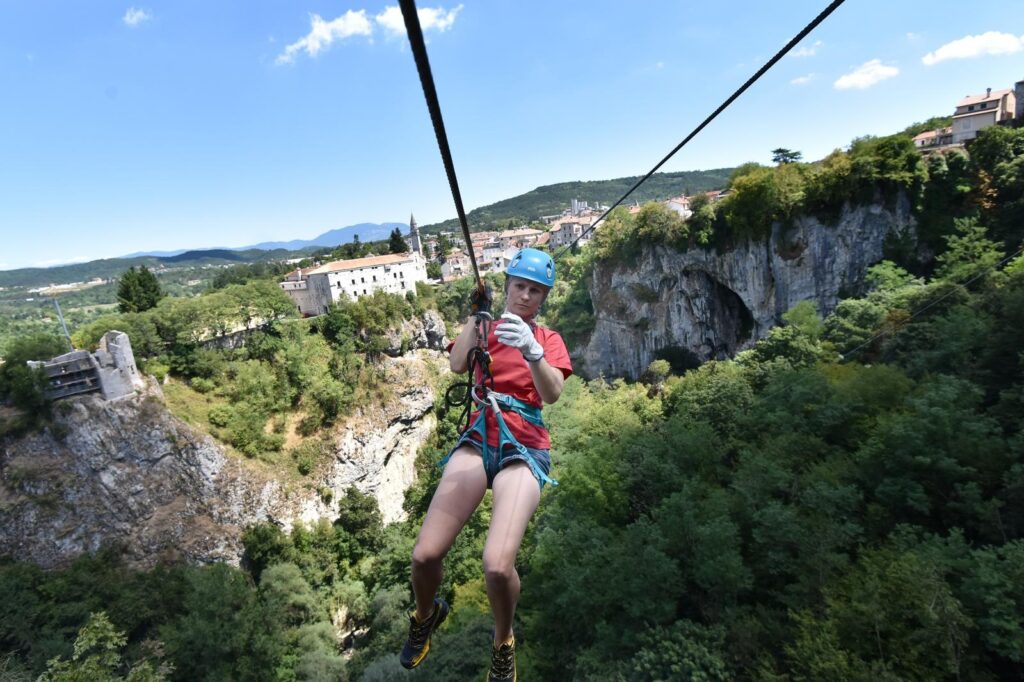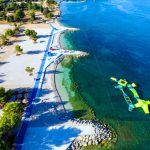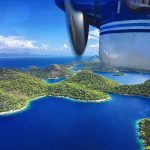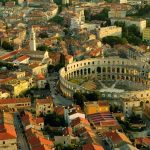Central Istria’s biggest town, Pazin is one of the best starting points if you want to explore the often neglected inland Istria, which can be just as enchanting as the coastal region.
- Welcome!
- How to get to Pazin and get around
- 5 things not to miss
- Where to stay?
- Where to eat?
- Top 3 day trips from Pazin
- 5 things you didn’t know about Pazin
Welcome!
Pazin is the seat of the Istria County, snatching the title from bigger cities such as Pula or Rovinj. Being far away from the sea, it hasn’t turned into a tourist hotspot. That means that it might seem a bit sleepy and uninteresting at the first glance. Yet, if you scratch below the surface, you will find out it makes for a worthwhile visit. Get ready for natural beauties, medieval heritage, and true Istrian food. If you are one of the visitors who prefer the calm interior of Istria, away from the busy coast, Pazin is for you.
How to get to Pazin and get around
Plane
The closest airport is located in Pula. If you continue by car, it will take you a bit over half an hour to get there – Pula’s airport is very close to Istria’s “Y” motorway system. If you use public transport, you will have to get to Pula and look for options there (more info below). Rijeka airport is also not far away, but from there it’ll take at least an hour and a half by road to reach Pazin. Yet longer might be the travel to the next closest airport, the one in Trieste.
Road
Pazin is located on the Istrian “Y” motorway and thus easily accessible from Rijeka, Zagreb, Slovenia, Italy, or Pula. If coming from Pula, it is not a bad idea to skip the motorway and take road 21 to Vodnjan, then road 5190 to Pazin – quaint Istrian towns like Savičenta or Žminj will be on your route! If coming from Rovinj, the motorway will also help, but route Brajkovići – Baderna – Rovinj is also a nice idea if you want to explore inland Istria.
Looking for a fast, reliable and trouble-free transfer to or from Pazin? Contact TC transfer partner Adriatic Transfers for your one-stop solution.
Pazin’s bus connections with Pula, Rovinj, Rijeka, or Zagreb are somewhat few and far between, but there are always a couple of lines daily. Make sure to check the bus connections on spot – the Internet can be quite unreliable about the bus lines in Croatia.
Rail
Pazin is one of the few Istrian towns accessible by rail. There are daily lines from Pula – the train is slow but reliable, and you are in for some nice sights on the ride. In the summer months, there is also a line to and from Ljubljana, Slovenia. Unfortunately, no trains run between Istria and the rest of Croatia.
Pazin is a small place so it’s easy to get around on foot. However, if you have a car, you’ll be able to explore much more of its attractions. Having a bike will also help, and biking trails abound in the surroundings of Pazin.
5 things not to miss in Pazin
Pazin Cave
The town’s main attraction is this wonder of nature, a sinkhole formed by the river Pazinčica. After being a proper on-the-surface river for some 18 kilometres, the river then sinks into a sinkhole in Pazin. Below the surface, it forms a cave with an underground lake. Visits are possible – contact the local speleological society for info. Another way to experience the place is doing a zipline across the sinkhole itself. If that sounds exciting, find out more on the Zipline Pazin Facebook page.
Zarečki Krov Waterfall
The cave is not the only wonder of nature that the small Pazinčica forms. Far from it! Just a couple of kilometres outside of the town, you will find this amazing waterfall, where the locals go for refreshment in the summer months. With gallons of freshwater pouring over you, who needs the sea?
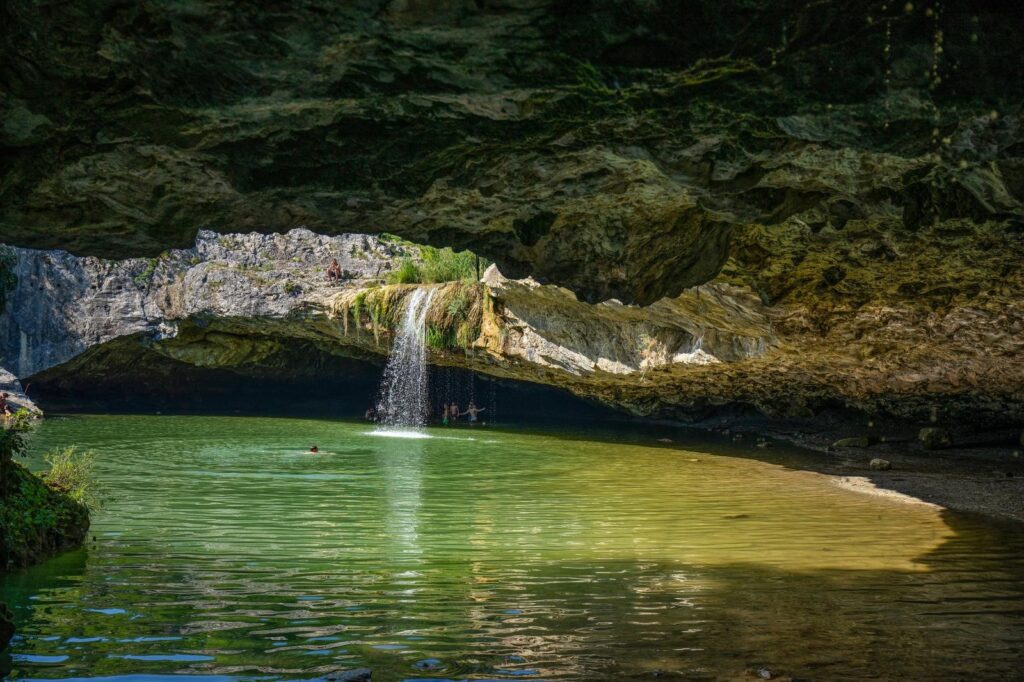
The name of the waterfall means that it’s located near the village Zarečje, while “krov” means “roof”. That describes the waterfall quite well: there is a rocky overhang over the spacious pool, and you can “hide” under it, using it as a roof. There are several similar waterfalls on the Pazinčica river, and Zarečki Krov is the most spectacular and popular one!
Hiking
Pazin is a place to be if you are into hiking, with various trails in the area – for more info, see the list of trails. Think hills, forests, and creeks. Our recommendation is the Grdoselo – Zelengrad trail. It starts in Grdoselo village, goes past the Butoniga stream and leads to the ruins of Zelengrad, a long-abandoned fortress. Another good idea is the walk from Pazin to Beram, a nearby village. There you will find one of Istria’s best-hidden treasures – more info in the entry below! The area is also known for bike routes – check them out if you’re traveling on two wheels.
Beram Danse Macabre
Danse Macabre was a popular artistic genre in the Middle Age. It features figures from all walks of life, from a Pope to a child, dancing their way to the grave in the company of Death itself, reminding people of its universality. A fine example of it is the fresco found in Beram’s Church of Marija na Škrilinah. The village is very close to Pazin and will take less than 10 minutes by car, and it’s a nice walk to it. Someone has to unlock the church for you – best to ask the residents to get you the contact of the church’s priest.
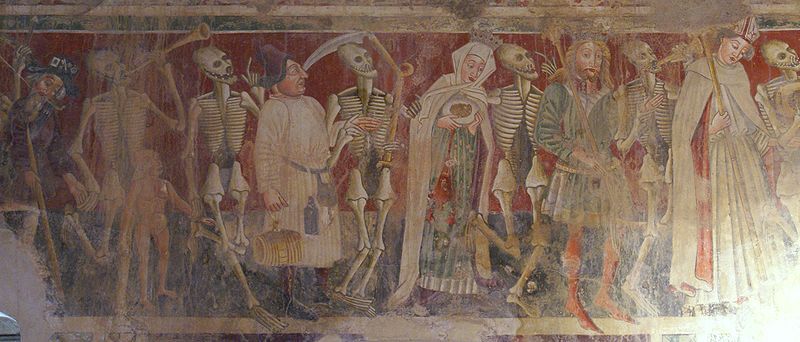
If frescoes are your thing, make sure to check the one in Pazin’s church of Saint Nicholas too. For more medieval art, visit the nearby village of Lindar and its Church of St. Catherine.
Pazin Castle
The biggest and best-preserved medieval fortress in Istria is Pazin’s Kaštel, located right above Pazin Cave. It was built sometime in the 10th century and changed hands many times, finally becoming the property of the Habsburg dynasty in the late 14th century. Serving as the centre of Habsburg’s Istria mark, it became the core of the present-day Pazin. Nowadays, the castle houses the Ethnographic Museum of Istria, as well as the Museum of the Town of Pazin.
Where to stay in Pazin
The only hotel in Pazin is Hotel Lovac, located a bit outside of the city centre, a decent place with a great view of Pazin’s castle and cave. There are no hostels, but many private houses and apartments are available both in the town itself and in the surrounding area. Many visitors to Istria choose to stay in villas with a pool in the interior, and there are plenty around Pazin. One great option a bit outside of Pazin is Resort Čiže, located in Trviž, some 15 minutes away by car from Pazin. Apart from offering luxury accommodation in an idyllic landscape, it is a campsite too. Some local family farms (OPGs) offer accommodation too – more on them in the “Where to eat” entry.
Where to eat in Pazin
The town itself doesn’t have much to recommend – apart from the aforementioned hotel Lovac’s restaurant – but its surroundings are worth exploring. One place to check out in Pazin proper is bakery La Marenda, run by a French couple and offering true French pastries.
Beram is not worth visiting for the death dance fresco only – the local konoba Vela Vrata offers proper central Istrian food, such as pasta and juicy pork cuts. If willing to drive for some 15 minutes, check out konoba Doma in the town of Sveti Petar u Šumi for more central Istrian food; they also offer their own cured meat products. Yet another great place near Pazin is konoba Puli Pineta in Žminj, one of the most creative places in the area. A big thing around Pazin are family farms, OPGs- like Stara štala in Borut, Stari kostanj near Gračišće or Ograde in Lindarski Katun. If you want to try old school Istrian food, look no further.
Top 3 day trips from Pazin
Motovun
This trip will require a car, as public transport is non-existent between Pazin and Motovun. The drive is worth in itself, as you will pass through the wilderness of central Istria. If you are feeling adventurous, take the road through Trviž and Kašćerga – it is narrow, bumpy and winding, but you’ll be rewarded by some stunning views. If you have a reliable SUV, the road Kašćerga – Zamask – Motovun is also an option. For the easiest route, take the road running through Brajkovići to Karojba, and then to Motovun. The most famous Istrian hilltop town shall offer plenty of opportunities to fill your day, from sightseeing, through truffle hunts, up to superb local wine.
Rovinj
A bit over half an hour away from Pazin if you take the motorway, some 45 minutes if taking the regular road, Rovinj is a must-see when visiting Istria. Whereas Pazin was the Austrian capital of Istria, Rovinj is its most Italian city. Due to the location of the old town – on a peninsula that once was an island – colourful houses, and landmarks such as the Church of Saint Euphemia, it is considered among the loveliest, if not the loveliest, places on the Croatian coast. It is not a big place so a day will be enough to explore all of its beauties.
Opatija
It’ll take less than one hour by car via the Y motorway to get to Opatija, located just across Učka, the mountain separating Istria from the rest of Croatia. This town is famous as the place where Croatian tourism originated. In the late 19th century, a number of hotels and villas were built there, turning the town into the fanciest resort on the then Austrian riviera. It attracted nobility from around Europe, including crowned heads such as the Austrian Emperor Franz Joseph himself. Although the place lost some of that prestige a long time ago, it kept much of its past splendour.
5 things you didn’t know about Pazin
Mitterburg
Pazin has this historical German name, owing to the aforementioned fact that it was owned by the Habsburg dynasty. Southern and western Istria were ruled by the Republic of Venice since the medieval times, which is how that part of Istria got its present-day charm. The central part of the peninsula was, however, ruled by the Habsburgs, with Pazin castle as its centre. Because of this, the castle saw many battles, as the Venetians tried to conquer the rest of the peninsula. Pazin succumbed to them only once, in 1508, with the Habsburgs quickly retaking it. In 1797, Napoleon abolished the Republic of Venice and the whole of Istria was shortly ruled by France, after which the entire peninsula came under Habsburg rule, which lasted until the end of World War 1.
Jules Verne
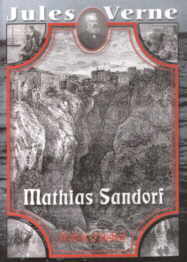
A part of the famous author’s novel Mathias Sandorf, about the eponymous count who plots to establish Hungarian independence from Austria, takes place in Pazin. Its castle is the place where Sandorf and his fellow conspirators are locked up to await execution for treason. They attempt to escape through the Pazin Cave, with the underground river leading them all the way to Rovinj. Verne never visited Istria, but relied on the works of author Charles Yriarte, who visited Pazin, and the photos of the town provided by its mayor. Today, a street in Pazin bears Verne’s name.
Juraj Dobrila
The man whose portrait you can find on the 10 Kunas note was born in the village of Ježenj, some three kilometres to the East from Pazin. Juraj Dobrila was a Catholic bishop of Trieste and Istria who, during the time of national awakenings throughout Europe, gained fame as an advocate for greater rights for Croats and Slovenes in Istria under the Austrian rule. Dobrila supported introducing Slavic languages into schools and public life, helped the establishment of the first local newspapers in the Croatian language, printed books in Croatian, and educated the local intelligentsia, all in order to stop the creeping Italianisation. A part of the Museum of the City of Pazin is dedicated to his life and work, and Pula’s university is named after him.
Pazin decisions
The decision for Istria to unite with Croatia was made in Pazin during World War II. After the capitulation of Italy in September 1943, the Istrian liberation committees quickly disarmed the Italian army, and took over almost the entire peninsula, proclaiming unification with the Croatian motherland soon after. They were quickly overpowered by the invading Nazis, who ruled the peninsula to the very end of the war. This didn’t stop the liberators from continuing the struggle, to which the Nazis retaliated with terror, but all in vain – the Yugoslav Army finally managed to drive them out and unite Istria with the rest of Croatia.
Draguć
This idyllic village some 20 minutes away from Pazin by car is sometimes called “Istrian Hollywood”. It is just quaint enough to “portray” medieval towns in a number of films. It also hosts a museum of frescoes (Kuća fresaka), and the view from it is spectacular.
More information
Central Istria tourist board’s webpage
To follow the latest news from Pazin, check out the dedicated TCN page.

